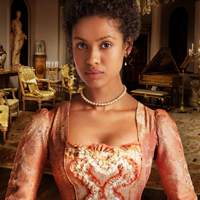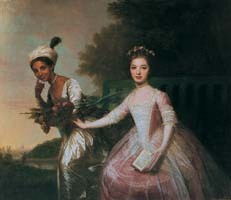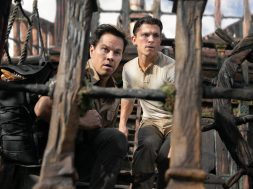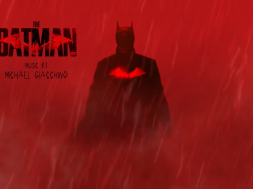

In the last few years, it seems that slavery has made it’s way into the eye of major motion pictures as poignant point onto which to base a narrative. Tarantino tackled it most famously with Django Unchained in 2012, a very good, but also very tongue in cheek attack on the slave driving of the deep south in the mid 1800’s, then most recently, 12 Years A Slave took a much more scathing, true to life look at the cruelty of slavery and how every ounce of worth put on someone of color back then was hard fought for and hard won. Now, director Ammo Asante has made a film which goes even further back, into the late 1700’s, and decides to look at slavery from the peripheral view of high society in Britain with Belle, a period piece that is much closer to 12 Years in substance, but perhaps suffers from a little too much of Django‘s glean.
 Based upon the famous painting of Dido Elizabeth Belle and Lady Elizabeth Murray which now resides in Scotland’s Scone Palace, Belle is a fiction based on fact period piece centering around the life of the aforementioned Dido, the film’s ‘Belle’, played by Gugu Mbatha-Raw.
Based upon the famous painting of Dido Elizabeth Belle and Lady Elizabeth Murray which now resides in Scotland’s Scone Palace, Belle is a fiction based on fact period piece centering around the life of the aforementioned Dido, the film’s ‘Belle’, played by Gugu Mbatha-Raw.
Born of a British naval officer and an African enslaved woman, Dido finds herself in her uncle’s care, 1st Earl of Mansfield William Murray, after her father sends her there when she is 26. Murray (Tom Wilkinson) chooses to raise her as a free woman with his wife alongside her cousin, Elizabeth Murray (Sarah Gadon), who was also under his full time custody.
Belle’s tenure in the family home coincides with an important legal case in which her uncle is to deliver a verdict on whether or not a ship was within it’s legal right to dump the slave cargo it held in order to receive an insurance pay-out. Bolstered by a young up and coming barrister, John Davinier (Sam Reid), who fought to sway her adopted father’s opinion on the matter, Belle’s story is her perspective on the case, how she affects the outcome, and how she herself found her humanity challenged at a time when her having anything at all was a rarity.
As a period piece, from the opening scenes, Belle looks stunning. High class in the late 1700’s Britain is incredibly well and vividly realized with all the well-mannered, sophisticated gentlemen courting all the beautiful, refined young women in a forum of who can get married first and who will inherit whose fortune. Every minute detail is seen to so that authenticity is communicated and every location used, from the dining room at breakfast, to a lakeside green for a forum of courtship, to inner-city life, feels alive and real to the audience as a place where these events may have taken place and where real people once lived.

While this is all well and good, however, without a doubt the highlight of the depiction in terms of realism is the dialogue. Wonderfully poetic and authentic feeling to the end, Misan Sagay’s grasp on how to not only make the language feel correct for the time, but also easily understood is excellent. There are many quote-worthy exchanges throughout the film, whether it be the despicable James Ashford (Tom Felton) denouncing Belle, or any of Davinier’s emotional exchanges, there is nay a word wasted and much of what is said feels distinctive and memorable.
Though the feature looks the part, what’s most important about Belle is the core narrative. Dealing with racism and slavery as themes is no easy task, and suitable care must be utilized in their handling, lest it seems clumsy or offensive. The poignancy with which Amma handles Dido’s self discovery against her discovering of how people of her lineage are treated is very well done, and never goes beyond the film’s own gentleness to make a point. There are two stories at play for much of the film; Davinier and Murray’s handling and discussion of the legal case before them, and Dido’s own practice of embracing her freedom to choose her life. These of course meet in the final act in a wonderful culmination of how she influences those around her and how they influence her and it’s all well and good. This leads to the problem with Belle – it’s almost too optimistic.
 While the positive outcome of the film is in line with historical events and as such is no surprise, the syrupy sweet idealism that seeps into every scene from when Belle and Davinier first meet proves ultimately a bit too sugary for the surrounding hard shell.
While the positive outcome of the film is in line with historical events and as such is no surprise, the syrupy sweet idealism that seeps into every scene from when Belle and Davinier first meet proves ultimately a bit too sugary for the surrounding hard shell.
There’s a great fist in the air feeling as the time for Murray’s decision comes and everything is marching with steady pace towards a very rosy sunset that just feels very juxtaposed with the accompanying time period and there’s almost a sense that punches are being pulled for the sake of not causing controversy.
But that aside Belle is still a very good film. Gugu carries herself as our Belle beautifully and with such grace that even if she wasn’t the main character, it would be hard not to avert our stare from her presence. The set-pieces are wonderful and the script flows from scene to scene incredibly well, capturing us in it’s ebb and flow with each passing sentence. While not containing the big names, or budgets, of it’s peers, Belle is a film very much worth seeing.
[easyreview cat1title=”The Arcade Verdict” cat1detail=”Looks the part with great casting, would have benefited from a touch more risk-taking.” cat1rating=”8″]
Belle is in cinemas nationwide from June 13th.










